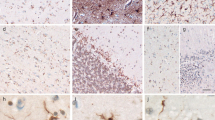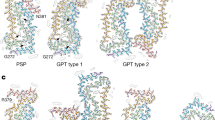Abstract
Argyrophilic and tau-positive abnormal structures occurring in glial cells are called glial fibrillary tangles. In the astrocyte, a conspicuous tau-positive structure is known to appear in progressive supranuclear palsy (PSP). In this report, another type of argyrophilic and tau-positive astrocytes is reported. The morphology of this new type is quite different from that of the previously reported tau-positive astrocyte in PSP and they are designated here as thorn-shaped astrocytes (TSA). TSA have an apparently argyrophilic cytoplasm with a few short processes and often have a small eccentric nucleus, whose appearance resembles that of a reactive astrocyte. Immunohistochemically, TSA are positive to anti-tau antibodies but are negative for ubiquitin. Simultaneous immunostaining revealed the coexistence of tau and glial fibrillary acidic protein epitopes in the same cytoplasm. Electron microscopically, bundles of 15-nm straight tubules were included in the cytoplasm together with abundant glial filaments. In the vicinity of a cluster of TSA, related structures of perivascular or subpial tau-positive linings, which correspond to astrocytic end-feet, are sometimes observed. In almost all cases, a few TSA are generally located in a confined area of subpial and subependymal regions. Although TSA appear to be intimately associated with some diseases, they are also found in a wide range of cytoskeletal disorders including the aged brain with neurofibrillary tangles. TSA are presumed to be a secondarily induced product in relation to astrocytic reaction.
Similar content being viewed by others
References
Akiyama H, Itagaki S, McGeer PL (1988) Major histocompatibility complex antigen expression on rat microglia following epidural kainic acid lesions. J Neurosci Res 20: 147–157
Amano N (1994) Glial fibrillary tangles and dementia. Dementia (Jpn) 8: 94–101
Braak H, Braak H (1989) Cortical and subcortical argyrophilic grains characterize a disease associated with adult onset dementia. Neuropathol Appl Neurobiol 15: 13–26
Braak H, Braak E, Ohm TG, Bohl J (1988) Silver impregnation of Alzheimer's neurofibrillary changes counterstained for basophilic and lipofuscin pigment. Stain Technol 63: 197–200
Feany MB, Dickson DW (1995) Widespread cytoskeletal pathology characterizes corticobasal degeneration. Am J Pathol 146: 1388–1396
Goedert M, Spillantini MG, Jakes R, Rutherford D, Crowther RA (1989) Multiple isoforms of human microtubule-associated protein tau: sequences and localization in neurofibrillary tangles of Alzheimer's disease. Neuron 3: 519–526
Hauw JJ, Verny M, Delaere P, Cervera P, He Y, Duyckaerts C (1990) Constant neurofibrillary changes in the neocortex in progressive supranuclear palsy: basic differences with Alzheimer's disease and aging. Neurosci Lett 119: 182–186
Ikeda K, Akiyama H, Kondo H, Ikeda K (1992) Anti-tau-positive glial fibrillary tangles in the brain of postencephalitic parkinsonism of Economo type. Neurosci Lett 162: 176–178
Ikeda K, Akiyama H, Haga C, Kondo H, Arima K, Oda T (1994) Argyrophilic thread-like structure in corticobasal degeneration and supranuclear palsy. Neurosci Lett 174: 157–159
Ikeda K, Akiyama H, Kondo H, Haga C (1995) A study of dementia with argyrophilic grains. Possible cytoskeletal abnormality in dendro-spinal portion of neurons and oligodendroglia. Acta Neuropathol 89: 409–414
Ikeda K, Akiyama H, Kondo H, Arai T, Arai N, Yagishita S (1995) Numerous glial fibrillary tangles in oligodendroglia in cases of subacute sclerosing panencephalitis with neurofibrillary tangles. Neurosci Lett 194: 133–135
Iwatsubo T, Hasegawa M, Ihara Y (1994) Neuronal and glial tau-positive inclusions in diverse neurologic diseases share common phosphorylation characteristics. Acta Neuropathol 88: 129–136
Nishimura M, Namba Y, Ikeda K, Oda M (1992) Glial fibrillary tangles with straight tubules in the brains of patients with progressive supranuclear palsy. Neurosci Lett 143: 35–38
Papasozomenos SC (1989) Tau protein immunoreactivity in dementia of Alzheimer type. II. Electron microscopy and pathogenic implications. Effects of fixation on morphology of the Alzheimer's abnormal filaments. Lab Invest 60: 375–389
Wakabayashi K, Oyanagi K, Makifuchi T, Ikuta F, Homma Y, Horikawa Y, Tokiguchi S (1994) Corticobasal degeneration: etiopathological significance of the cytoskeletal alterations. Acta Neuropathol 87: 545–553
Yamada T, McGeer PL (1990) Oligodendroglial microtubular masses: an abnormality observed in some human neurodegenerative diseases. Neurosci Lett 120: 163–166
Yamada T, McGeer PL, McGeer EG (1992) Appearance of paired nucleated, Tau-positive glia on patients with progressive supranuclear palsy brain tissue. Neurosci Lett 135: 99–102
Yamada T, Calne DB, Akiyama H, McGeer EG, McGeer PL (1993) Further observations on Tau-positive glia in the brains with progressive supranuclear palsy. Acta Neuropathol 85: 308–315
Yamazaki M, Nakano I, Imazu O, Kaieda R, Terashi A (1994) Astrocytic straight tubules in the brain of a patient with Pick's disease. Acta Neuropathol 88: 587–591
Author information
Authors and Affiliations
Rights and permissions
About this article
Cite this article
Ikeda, K., Akiyama, H., Kondo, H. et al. Thorn-shaped astrocytes: possibly secondarily induced tau-positive glial fibrillary tangles. Acta Neuropathol 90, 620–625 (1995). https://doi.org/10.1007/BF00318575
Received:
Accepted:
Issue Date:
DOI: https://doi.org/10.1007/BF00318575




